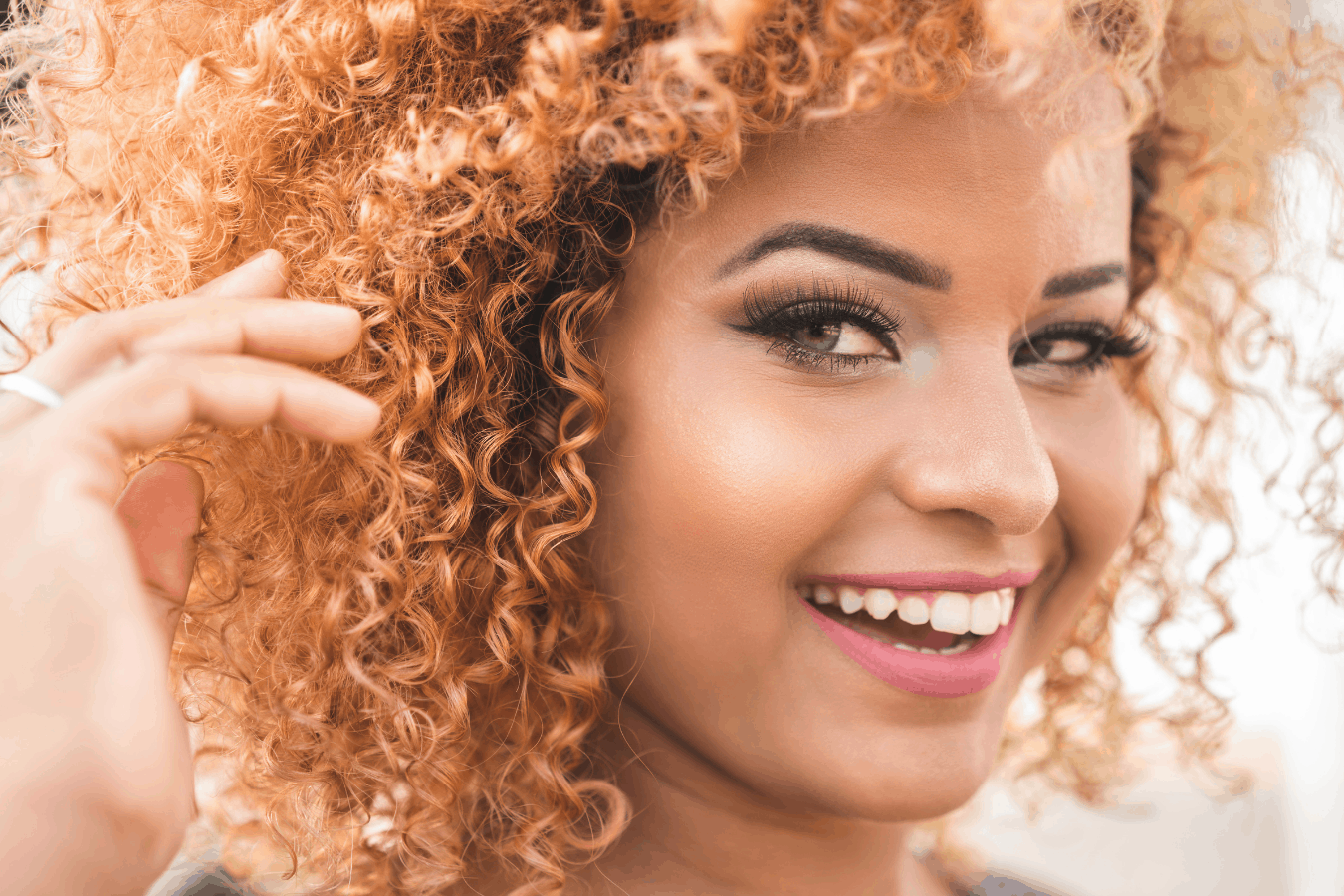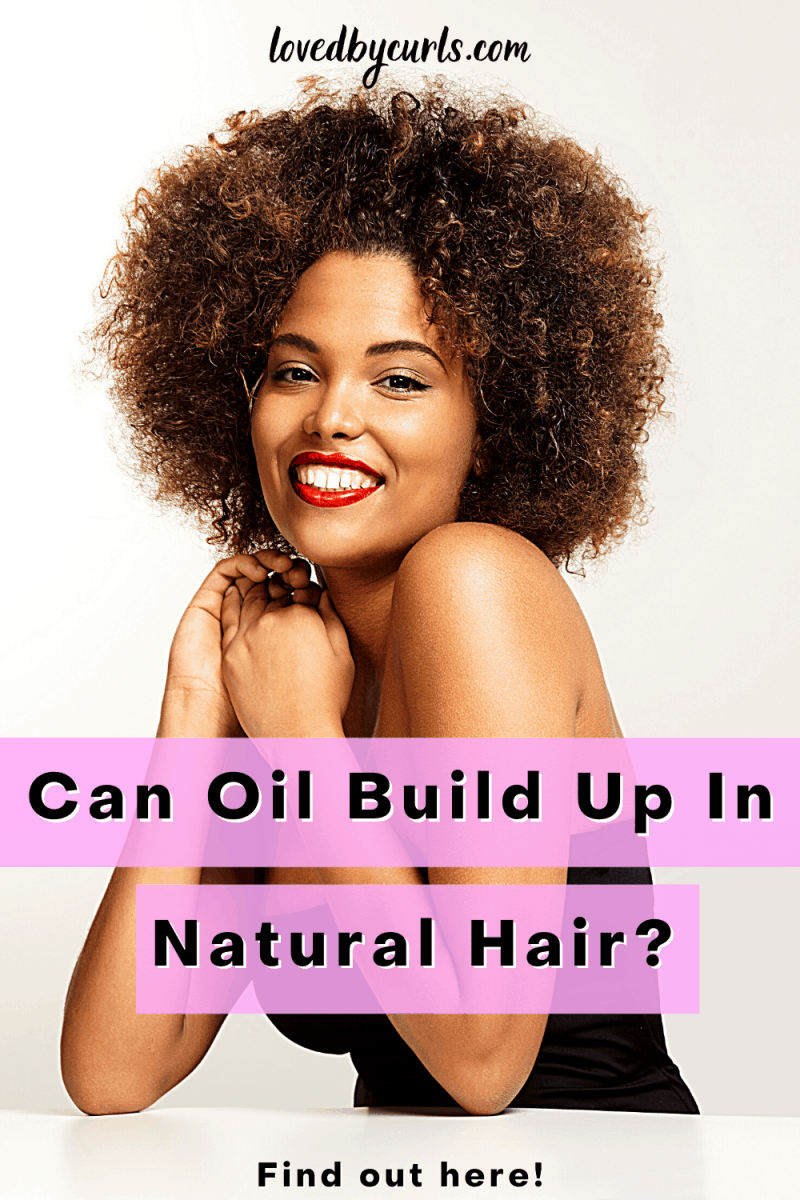Your scalp produces natural oils that help moisturize and hydrate your hair. But can oil build up in natural hair? If so, why does this happen, and what can you do to help it?

The answer is yes, oil can build up in natural hair. In some instances, this oil build-up will eventually result in scalp build-up or product build-up. This is often mistaken for dandruff, as little flakes of dead skin detach from your scalp.
Excess oil build-up in natural hair happens for a number of reasons, from the type of products you’re using to hair type. Thankfully, there are a number of ways to manage this build-up.
Why Does Oil Build Up In Natural Hair?
In order to understand why oil can build up in natural hair, it’s important to know what role sebum and sweat play in the body.
Sebum is a natural waxy oil created by the sebaceous glands. It plays a really important role in maintaining the moisture in your skin.
By forming an oily barrier, the sebum works both to lock in that moisture and to prevent infection.
If your scalp produces too much sebum, however, you’ll end up with excess oil build-up in your natural hair.
Equally, your scalp naturally produces sweat, known as eccrine sweat. This is acidic, with a pH value of around 4.5 – 6.
Both the sebum and sweat that your scalp makes constitutes its ‘acid mantle’, which both prevents microbiological growth and protects the scalp.
Also Read: 15 Best Gels For 4C Hair
What Can Cause Oil To Build Up In Natural Hair?
There are a number of reasons why oil can build up in natural hair. These are the usual culprits:
Over-washing
You may think you’re doing your hair a favor by washing it so frequently, when in fact you’re doing the opposite.
This is because, when you wash your hair, your scalp learns to produce more sebum. This is particularly true if you use a sulfate shampoo.
Sulfate shampoo can be very harsh on your scalp as it removes natural oils from your hair. This causes your scalp to overproduce sebum.
As discussed above, with more sebum comes more oil, resulting in oil build-up in your natural hair.
Too much sebum will also disrupt your scalp’s ‘acid mantle’, which allows for the growth of microorganisms that can contribute to dandruff.
Also Read: Growing Edges: How To Avoid Thinning Hair With These 5 Tips
Co-washing Too Often
Co-washing is when you wash hair using only conditioner. It’s an important step in various regimes – particularly for afro and curly hair.
Unfortunately, co-washing your hair too much can cause oil to build up in natural hair.
Many curlies address this issue by chelating their hair once a month or use a sulfate-free cleanser.
If you find that your hair stays greasy and that you cannot remove the build-up, using a sulfate shampoo once a month or every 6 weeks could be the way to go.
Also Read: 12 Best Flat Irons for Natural Hair (2021 Buying Guide)
Using The Wrong Products
It’s worth being conscious of the products you use.
Many hair products, particularly styling creams or gels, contain substances that are very waxy.
If not thoroughly rinsed, like silicone, this wax will build up and cause a residue that coats hair strands, resulting in oil build-up in natural hair.
If you’re over co-washing your hair, this will also interact badly with products, as they won’t be able to activate.
This then results in product build-up which forms on top of the cuticle, making hair look greasy.
Hair Type
It’s less good news for any readers with straight hair, as this is more vulnerable to oil build-up.
With less texture or wave to the hair shaft, the oil has nothing to disrupt its journey down the hair shaft. This means it’s more likely to both build up and to be more visible in straight hair.
Sweat
Your scalp will naturally produce dead skin flakes, sebum, and sweat. If you’re prone to sweating, or if you exercise enough, your scalp will therefore make more sweat. This can then cause hair to look greasy.
Finally, remember that oil build-up on natural hair could also be happening because of a combination of factors.
For example, if you exercise hard regularly and have hair that’s naturally inclined to excess oil.
Like this? Read our guide on the best hair dryers for natural hair.
How Can I Tell If I Have Oil Build-up In My Natural Hair?

There are a few typical ‘tells’ that you can use in order to gauge whether you’ve got oil build-up in your hair:
Greasy Hair
If your natural hair is looking a bit limp, this is the usual sign that there’s oil build-up.
You may also be able to see the residue in your hair’s roots, which can result in flaking if untreated.
Avoiding products that contain petrolatum, silicones, or mineral oil can help, as these are known to cause oil build-up in natural hair.
Lack Of Moisture Absorption
Have you found that your normally moisture-absorbent hair isn’t taking to a product like normal?
It’s likely that it’s suffering from excess oil or product build-up, as your strands just can’t absorb moisture in the way they usually do.
Less Curl Than Usual
For maximum curls, it’s all about hydration. When there’s too much oil build-up in natural hair, your strands can’t absorb enough moisture to form their full coil pattern.
Plus, any residue will end up weighing down those curls, resulting in flatter, less-defined hair.
Also Read: How Does Alcohol Get Into Your Hair? (Interesting Facts)
Dull Hair
With an overabundance of oil build-up, your hair just can’t find its natural shine.
The follicle will be clogged as a result of this build-up, and hair can end up being extremely dull and matte in appearance.
Having a balanced hair care routine is the first step to avoiding unnecessary oil build-up in natural hair.
Use a sulfate-free shampoo in order to wash your hair, and aim to do this every 4 – 7 days.
That way, you’ll help to manage your sebum production, and remove the general grime that your hair picks up from daily life.
If you think you have excess oil build up in your natural hair, you can use a clarifying, moisturizing, detoxifying shampoo in order to get rid of excess product and oil.
These shampoos will thoroughly cleanse the scalp and hair shafts. They can be a bit harsh, which is why you want to find one that will moisturize and protect your hair strands whilst still cleaning.
What If Using Oil Is Part Of My Hair Care Routine?
We understand that using oil is an important step in the hair care of many curly girls.
You may use either the LOC or the LCO method, that’s either liquid/oil/cream or liquid/cream/oil, in order to maximize and seal in your hair’s moisture.
These methods can make a significant difference to curly girls who experience dry, frizzy hair.
Don’t panic, we’re not here to tell you to stop that.
There are also benefits to oiling your scalp, as this can help to prevent scalp build-up in the first instance. Oil also works as a detangler, so can help keep your locks separate and frizz-free.
Furthermore, oil can also help to mitigate hygral fatigue and works to protect the hair follicles during the washing process.
That’s why it’s best to oil your scalp before you shampoo.
So don’t worry, you can use oil as part of your hair care routine without it being a problem, and without resulting in excess oil build up in natural hair.
How And When To Use Oil In Natural Hair
Oils like peppermint, tea tree, and citrus have a fantastic decongestant effect, and will work to clarify the scalp.
You want to be looking at oils that are anti-inflammatory and cleansing, with anti-fungal properties.
However, if you’re vulnerable to dandruff, it’s best to stick to water-based products.
Particular oils will contribute to excess sebum and promote the growth of unhealthy bacteria, which will only feed certain conditions like dandruff.
When massaging oil into your scalp, start at the base of your neck using both hands, and work your fingers up to the crown.
Take your time, as there’s a lot of scalp to cover. Working from the base of your ear up to your head’s top on both sides is best.
We recommend spending 3 – 5 minutes doing so. This will maximize exfoliation, removing debris and dirt, encouraging blood flow, and softening skin cells.
If you want to use grease in your hair regimen, be sure to use either water or a water-based leave-in conditioner before you do so.
The grease then acts as a protective layer on top to seal in moisture. Alternatively, you can use a natural pomade to do the same.

Disclaimer: This site is not intended to provide professional or medical advice. All of the content on LovedByCurls.com is for informational purposes only. All advice should be followed at your own discretion. Ingredients may change at any time so always check the product label before using. Check our full disclaimer policy here.
